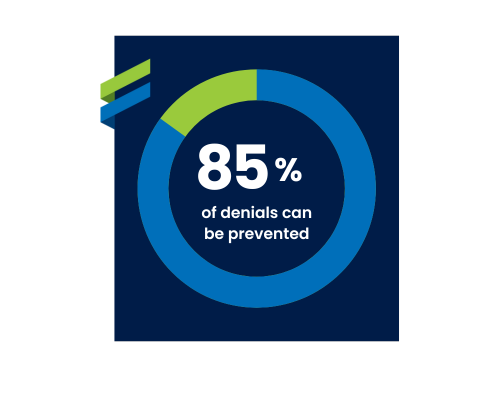Blog & Insights
Busting Common Myths About Denials

Denials are as much a part of healthcare revenue cycle management (RCM) as doctor’s bills, insurance claims, and patient payments. Yet, despite their commonality, many misconceptions continue to swirl around this aspect of the revenue cycle. Worse still, these misconceptions are causing extra – and ultimately unnecessary – work for already short-staffed RCM organizations.
During a recent webinar hosted by the Health Management Academy (THMA), I discussed the three most common myths around denials and how automation can better manage this process. Let’s take a look.
Myth 1: Denials are unavoidable
For many RCM leaders, there is an inherent belief that denials are, at the end of the day, unavoidable. This is, in my opinion, somewhat understandable. Given that denials find their root in so many elements of the revenue cycle, they can feel unavoidable. Those include:
- Registration issues
- Eligibility verification
- Prior authorization
- Coverage issues
- Coding (CDM hard-coded issues as well as soft-codes generated by HIM)

Though this sentiment may be understandable and while we can never eliminate them entirely, viewing denials as “unavoidable” waves a premature white flag. Through the process of denial prevention (also known as denial avoidance), a surprising number of denials actually can be prevented with scalable upstream efforts.
The truth is that, by identifying the root cause of a denial and fixing any front-end issues, denial volume can decrease considerably. In fact, according to the HFMA and Healthcare Finance, 85% of denials can be prevented.
Myth 2: RCM teams can keep up with the growing volume of denials
Nearly 50% of healthcare providers saw an overall increase in their denial rates in 2023 compared to the previous year. Denials are likely to continue to increase, particularly as more insurance providers leverage automation to review insurance claims. The output of this automation cannot be met by hiring more heads to “work denials,” at least not in an effective manner.
Further, as the number of denials increases, so does the workload on your employees. That’s a problem, as a 2023 survey of hospital and healthcare leaders revealed that 100 percent of survey respondents say staffing shortages have affected RCM efforts. And 69% of survey respondents see these staffing challenges continuing for the long term.
This is due, in part, to the high cost of labor, compounded by the training required simply to get new employees up to speed.
Unsurprisingly, RCM teams are unable to keep up with the growing number of denials. Overworked and understaffed organizations often:
- Lack in-house expertise
- Miss timely filing deadlines
- Assume the denial can’t be overturned.
In addition, many organizations are shifting priorities to focus on denial prevention – an admirable shift of perspective. But this shift often leaves up to 65% of denials unworked as the focus moves to root cause but without an effective way of “balancing the load” or otherwise ensuring that the front-end efforts reverse the trend of growing denials on the back end. The result? Upwards of $3.25 million in lost revenue for your average health system.
The key to addressing this head on is a classic instance of “fight fire with fire.” Since insurance companies are using automation to deny claims, it makes sense that RCM organizations use automation to manage and inform their denial processes. True automation of processes allows hospitals and health systems to leap to the next level of the efficiency curve, tapping into cohorts of denials not currently being (adequately) addressed and increasing net revenue in the process.
Myth 3: Denials must be worked by people
RCM leaders don’t have much of a choice; they must assign staff to manage denials. As the denials continue to increase, predictably more and more staff are needed to handle it. In essence, the need for headcount rises perfectly linearly with the volume of denials – hardly a model for efficiency.

Even if a health system is able to absorb that particular inefficiency, continued workforce shortages and risings costs associated with hiring more staff make it all but unsustainable to keep “throwing people at the problem.”
Fortunately, when taking a close look at some of the most common categories for denials, it becomes evident that many of these denial types can be handled by bots, including:
- Invalid coordination of benefits (COB) or no coverage
- Incorrect/missing information
- Additional documentation requirements
- And more.
Automation and denial management
As mentioned earlier, insurance providers are already using automation to review claims, leading to an increase in denials. These automated systems are being used to validate claims against policy terms and conditions. If the submitted claim doesn’t meet certain criteria, it is often automatically denied.
Insurance providers are also using automation for other tasks, including:
- Pre-authorization
- Medical necessity review
- Fraud detection
- And more.
With the growing number of denied claims plaguing revenue cycle operations, there has never been a more appropriate time for RCM organizations to battle this automation with automation of their own. To do so, these organizations must take advantage of robotic process automation (RPA). This tool can be used to manage the more complex tasks associated with denial management. Given the fact that a claim can be denied for several reasons, automating the process of gathering the necessary information to analyze why the claim was denied becomes a critical time-saver.
Some of the processes that can be automated include:
- Categorizing: Denials can be categorized as clinical vs. technical for appropriate routing and follow-up.
- Payer mapping: Mapping by payer can aid in workflow and root cause analysis.
- Transmitting 835 EDI files: Determine root cause and route for appropriate workflow.
- Appeals: Workflows specific to Level 1-3 appeals can be added, including necessary actions and result codes.
- RPA-driven tasks associated with:
- Invalid coordination of benefits or no coverage
- Incorrect or missing information
- Additional documentation requirements
- Adjustment postings
- And more.
The battle continues
As insurance companies continue to apply more scalable tactics in defining and identifying candidates for denials, the knowledge necessary to work a denial can no longer be contained within a static employee manual or similar document. The details of this ever-evolving process must be passed from employee to employee, which means that staffing losses negatively affect this tribal knowledge.
Fortunately, RCM organizations can use data and automation to help manage this process and, in turn, improve the chance of a claim being approved. Think of it like another application of automation familiar to us all: modern map and navigation apps. The app is aware of the desired endpoint (your destination) and is constantly evaluating what is ahead. Then it recommends adjustments and pushes them automatically to the user. This is most frequently done in the form of a newly suggested route to avoid traffic that has emerged along the way.
Within the realm of denials, that same concept of data and automation can help revenue cycle teams track the changing preferences and rules of payers. In turn, RCM teams can use them to chart new courses toward their desired destination. In this case, that means paid claims and dramatically lowered denial rates.
With denial rates continuing to increase, I would argue that healthcare providers and their RCM teams must combat automated denial strategies with automation of their own, lest they find themselves in an inescapable spiral of lost revenue.
